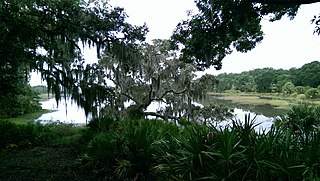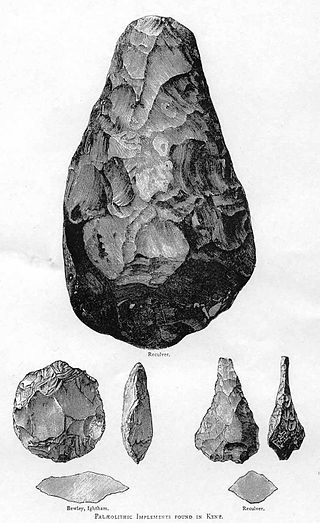Related Research Articles

Monte Verde is an archaeological site in the Llanquihue Province in southern Chile, located near Puerto Montt, Southern Chile, which has been dated to possibly as early as 18,500 cal BP. Previously, the widely accepted date for early occupation at Monte Verde was about 14,500 years cal BP. This dating added to the evidence showing that the human settlement of the Americas pre-dates the Clovis culture by roughly 1,000 years. This contradicts the previously accepted "Clovis first" model which holds that settlement of the Americas began after 13,500 cal BP. The Monte Verde findings were initially dismissed by most of the scientific community, but the evidence then became more accepted in archaeological circles.

The Upper Paleolithic is the third and last subdivision of the Paleolithic or Old Stone Age. Very broadly, it dates to between 50,000 and 12,000 years ago, according to some theories coinciding with the appearance of behavioral modernity in early modern humans, until the advent of the Neolithic Revolution and agriculture.

St. Catherines Island is a sea island on the coast of the U.S. state of Georgia, 42 miles (80 km) south of Savannah in Liberty County. The island, located between St. Catherine's Sound and Sapelo Sound, is ten miles (16 km) long and from one to three miles (5 km) wide. It covers approximately 22,265 acres, with about half of the acreage being salt marsh, while the remaining acreage is wooded. There are fine beaches on the northeast and south sides. The island is owned by the Saint Catherines Island Foundation and is not open to the public, apart from the beach below the mean high water line.

The Sam Noble Oklahoma Museum of Natural History is a natural history museum located on the campus of the University of Oklahoma. The museum was founded in 1899 by an act of the Oklahoma Territorial Legislature. Its current building was completed in 1999. The museum contains approximately "7 million objects and specimens in 12 collections." It has almost 50,000 sq ft (4,600 m2) of exhibit space, with five galleries and exhibits that provide an in-depth tour of Oklahoma's natural history. It is "one of the world's largest university-based natural history museums."
The Big Eddy Site (23CE426) is an archaeological site located in Cedar County, Missouri, which was first excavated in 1997 and is now threatened due to erosion by the Sac River.

Accokeek Creek Site, also known as Moyaone, is an archaeological site in Prince George's County, Maryland, located along the Potomac River across from Mount Vernon in today's Piscataway Park, which was inhabited intermittently since 2000 BC. Accokeek Creek Site was declared a National Historic Landmark in 1964.
Prehistory of Colorado provides an overview of the activities that occurred prior to Colorado's recorded history. Colorado experienced cataclysmic geological events over billions of years, which shaped the land and resulted in diverse ecosystems. The ecosystems included several ice ages, tropical oceans, and a massive volcanic eruption. Then, ancient layers of earth rose to become the Rocky Mountains.

Prehistory of Ohio provides an overview of the activities that occurred prior to Ohio's recorded history. The ancient hunters, Paleo-Indians, descended from humans that crossed the Bering Strait. There is evidence of Paleo-Indians in Ohio, who were hunter-gatherers that ranged widely over land to hunt large game. For instance, mastodon bones were found at the Burning Tree Mastodon site that showed that it had been butchered. Clovis points have been found that indicate interaction with other groups and hunted large game. The Paleo Crossing site and Nobles Pond site provide evidence that groups interacted with one another. The Paleo-Indian's diet included fish, small game, and nuts and berries that gathered. They lived in simple shelters made of wood and bark or hides. Canoes were created by digging out trees with granite axes.

The LoDaisKa site is a prominent archaeological site in the U.S. state of Colorado, located within a rockshelter near Morrison. The rockshelter was first inhabited by people of the Archaic through the Middle Ceramic period, generally spanning 3000 BC to 1000 AD.
The Trinchera Cave Archeological District (5LA9555) is an archaeological site in Las Animas County, Colorado with artifacts primarily dating from 1000 BC to AD 1749, although there were some Archaic period artifacts found. The site was added to the National Register of Historic Places in 2001 and is located on State Trust Lands.

The following outline is provided as an overview of and topical guide to the prehistoric people of Colorado, which covers the period of when Native Americans lived in Colorado prior to contact with the Domínguez–Escalante expedition in 1776. People's lifestyles included nomadic hunter-gathering, semi-permanent village dwelling, and residing in pueblos.
Prehistoric technology is technology that predates recorded history. History is the study of the past using written records. Anything prior to the first written accounts of history is prehistoric, including earlier technologies. About 2.5 million years before writing was developed, technology began with the earliest hominids who used stone tools, which they may have used to start fires, hunt, and bury their dead.
Keatley Creek is a significant archaeological site in the interior of British Columbia and in the traditional territory of the St'at'imc peoples. Its location is in the Glen Fraser area of the Fraser Canyon ranchlands about 18 miles from the town of Lillooet on a benchland flanking Keatley Creek, whose name derives from a former ranch owner, and from which the site takes its name.

The following outline is provided as an overview of and topical guide to prehistoric technology.

The Dumaw Creek Site is an archaeological site designated 20OA5, located along Dumaw Creek northeast of Pentwater, Michigan, that was the location of a 17th-century village and cemetery. It is one of the youngest pre-historic sites in Michigan, dating to the terminal Late Woodland Period just prior to European contact. It was listed on the National Register of Historic Places in 1972.

The Gault archaeological site is an extensive, multicomponent site located in Florence, Texas, United States on the Williamson-Bell County line along Buttermilk Creek about 250 meters upstream from the Buttermilk Creek complex. It bears evidence of almost continuous human occupation, starting at least 16,000 years ago—making it one of the few archaeological sites in the Americas at which compelling evidence has been found for human occupation dating to before the appearance of the Clovis culture. Archaeological material covers about 16 hectares with a depth of up to 3 meters in places. About 30 incised stones from the Clovis period engraved with geometric patterns were found there as well as others from periods up to the Early Archaic. Incised bone was also found.
Tham Lod Rockshelter, first researched by Rasmi Shoocongdej from Silpakorn University, funded by the Thai Research Fund, was a prehistoric cemetery and a workshop located in Northern Thailand known to have human inhabitants from the late Pleistocene to the late Holocene period Additionally, Tham Lod is near Ban Rai, another rock shelter and is in the vicinity of two well known caves, Spirit Cave and Tham Lot cave. Recent researches and carbon dating suggested that Homo sapiens have occupied the area. These researches provide more detail on the activities by the humans in the area which includes burials, living habits, gathering, and tool making, and social interactions.

The Anzick site (24PA506) in Park County, Montana, United States, is the only known Clovis burial site in the New World. The term "Clovis" is used by archaeologists to define one of the New World's earliest hunter-gatherer cultures and is named after the site near Clovis, New Mexico, where human artifacts were found associated with the procurement and processing of mammoth and other large and small fauna.
The Plains Village period or the Plains Village tradition is an archaeological period on the Great Plains from North Dakota down to Texas, spanning approximately 900/950 to 1780/1850 CE.

Paleo Crossing site, also known as the Old Dague Farm site, is an archaeological site near Sharon Center, Ohio in Medina County where Clovis artifacts dated to 10,980 BP ± 75 years Before Present were found. The Cleveland Museum of Natural History conducted an excavation from 1990 to 1993. The site provides evidence of Paleo-Indians in northern Ohio and may be the area's oldest residents and archaeologist Dr. David Brose believes that they may be "some of the oldest certain examples of human activity in the New World." The site contains charcoal recovered from refuse pits. There were also two post holes and blades and tools 80% of which were made from flint from the Ohio River Valley in Indiana, 500 miles from Paleo Crossing, which indicates that the hunter-gatherers had a widespread social network and traveled across distances relatively quickly. The post holes are evidence that there was a shelter built on the site.
References
- 1 2 Wyckoff, Don G.; Taylor, Lyonel (February 1971). "The Pumpkin Creek Site: An Early Archaic Camp on the Southern Plains Border". Plains Anthropologist. Plains Anthropological Society. 16 (51): 20–51. JSTOR 25666971.
- ↑ "Love County". Oklahoma State University Library. Retrieved October 9, 2013.
- ↑ "The Pumpkin Creek Site". University of Oklahoma. Retrieved October 9, 2013.